Explore Kunming - China Travel, Asia
Nestled in the heart of Yunnan Province, Kunming is a city where the past meets the present, and nature’s splendor is on full display. Kunming, known as the "Spring City" for its pleasant year-round weather, is a bustling city full of natural beauty, contemporary conveniences, and cultural diversity. From its ancient streets to its bustling markets, Kunming invites travelers to explore its unique charm, offering a perfect blend of history, culture, and adventure. Whether you’re drawn by its stunning landscapes or intrigued by its diverse ethnic heritage, Kunming has something for every traveler.
Population: Approximately 8.4 million in 2020.
Economy: As the main commercial hub of Southwest China, Kunming’s economy takes advantage of 3 main aspects: natural resources, gigantic consumer market and mild climate.
Landmarks: Famous for the Stone Forest in Shilin National Park, Green Lake Park, and Western Hills.
China
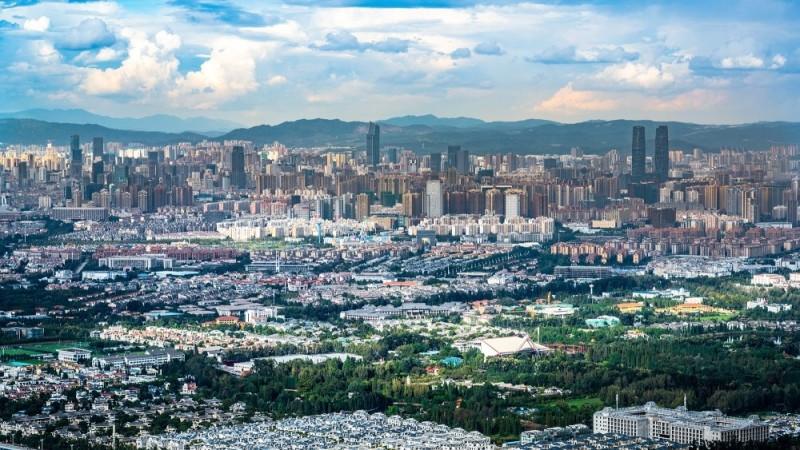
Overview of Kunming
History & Culture Influence
The history of Kunming is one of prosperous commercial routes, historic routes, and a plethora of cultural influences. As the capital of Yunnan Province, Kunming has been a significant cultural and political hub for centuries. It was once a vital stop along the Southern Silk Road, connecting China to Southeast Asia and beyond. This rich history is still palpable today, from the ancient temples that dot the city to the traditional festivals celebrated by its diverse population.
The city is home to many ethnic minorities, including the Yi, Bai, and Hui, each contributing to Kunming’s vibrant cultural tapestry. Their influence can be seen in everything from the city’s architecture to its culinary traditions. Temples and pagodas stand as testaments to the city’s Buddhist heritage, while colorful festivals bring the streets to life, celebrating the customs passed down through generations.
Interaction with The Locals
Kunming, the capital of Yunnan Province, is home to over 8.4 million people. The city is known for its diverse population, with over 25 ethnic minority groups, including the Yi, Bai, Hui, and Dai people, adding to its rich cultural tapestry. Kunming’s citizens are known for their friendliness and hospitality, making it easy for visitors to feel welcome. The city’s vibrant mix of cultures is reflected in its festivals, cuisine, and daily life, offering travelers a unique and immersive experience.
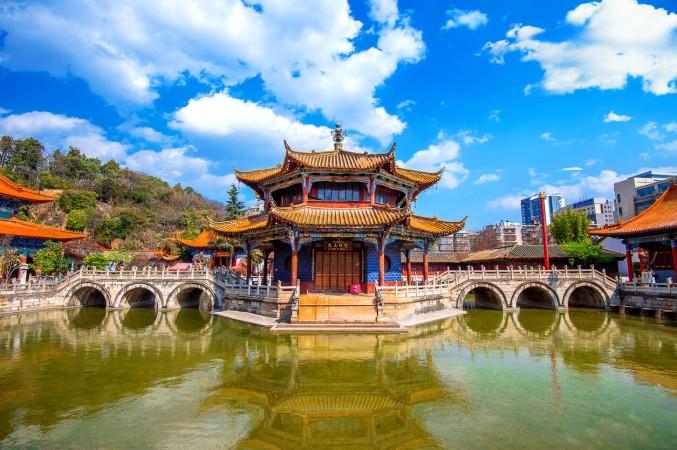
Yuantong Temple - © iStock
Top Attractions in Kunming
Kunming is a city of contrasts, where natural wonders sit alongside historical landmarks. These are some must-visit attractions in Kunming that showcase the best of what the city has to offer:
Stone Forest (Shilin National Park)
Just a short drive from the city, this UNESCO World Heritage Site is a geological wonder. The Stone Forest’s towering limestone formations create a surreal landscape that has fascinated visitors for centuries. It’s a place where nature’s artistry is on full display, making it a must-see for any traveler.
Green Lake Park (Cuihu Park)
Located in the heart of Kunming, Green Lake Park is a serene escape from the city’s hustle and bustle. Known for its stunning lotus blossoms in summer and migratory seagulls in winter, the park is a favorite spot for both locals and tourists. Whether you’re taking a leisurely stroll or enjoying a boat ride on the lake, this park offers a peaceful retreat.
Western Hills (Xishan)
Hiking enthusiasts love the Western Hills because they provide expansive views of Dianchi Lake. The area is home to several temples and pavilions, including the Dragon Gate Grottoes, where visitors can enjoy breathtaking vistas and explore ancient carvings. The combination of natural beauty and cultural significance makes this a must-see.
Yunnan Nationalities Village
For those interested in the cultural diversity of Yunnan Province, this village is a perfect introduction. The park features replicas of traditional homes and showcases the customs, costumes, and traditions of Yunnan’s many ethnic groups. It’s a vibrant and educational experience that brings the province’s rich heritage to life.
Dongchuan Red Land
Located about 150 kilometers northeast of Kunming, Dongchuan Red Land is a hidden gem known for its striking red soil, which creates a patchwork of vibrant colors across the landscape. The best time to visit is in the late afternoon when the setting sun illuminates the fields, creating a breathtaking spectacle. This rustic setting makes for an amazing background for photos and wildlife enthusiasts alike to create priceless memories.
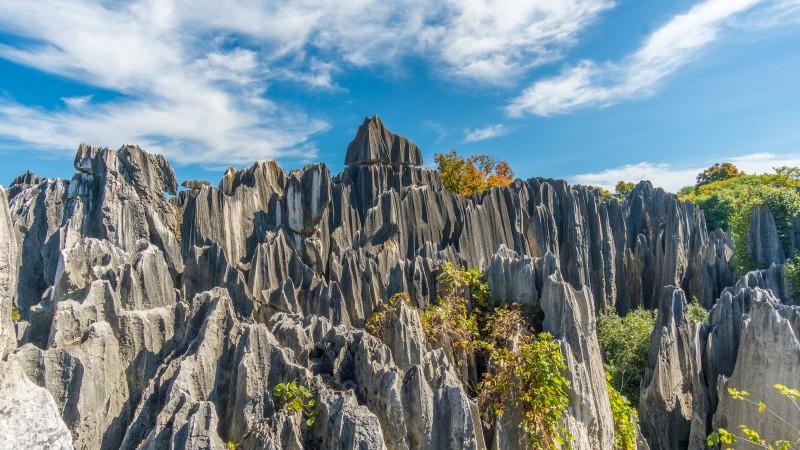
Stone Forest - © MIA
Must-Try Dishes in Kunming
Kunming’s culinary tradition offers a delightful array of dishes that highlight the unique flavors of Yunnan Province. Give these dishes a taste and you will experience a true taste of the local cuisine:
- Across the Bridge Rice Noodles (Guoqiao Mixian): This iconic dish features thinly sliced meats, fresh vegetables, and rice noodles, which are added to a hot, flavorful broth right at your table. The steaming broth cooks the ingredients, creating a deliciously aromatic and customizable meal.
- Yunnan Ham (Xuanwei Ham): Renowned for its rich and deep flavor, this cured ham is a staple in Yunnan cuisine. It’s commonly used in soups, stir-fries, and as a savory addition to various dishes, providing a distinctive taste that reflects the region’s culinary heritage.
- Steam Pot Chicken (Qiguo Ji): A traditional dish cooked in a unique clay pot, which infuses the chicken with the flavors of medicinal herbs and spices. This method of cooking results in tender, flavorful chicken and a broth that’s both nourishing and delicious.
- Erkuai: A type of rice cake that’s either grilled or stir-fried, Erkuai is typically served with a spicy, flavorful sauce. This dish is a popular street food item, offering a chewy texture and robust taste that’s both filling and delicious.
- Cross-Bridge Tofu (Guoqiao Doufu): A vegetarian twist on the classic Across the Bridge Rice Noodles, this dish features tofu instead of meat. Served with a variety of fresh vegetables and a savory broth, it’s a hearty and satisfying option for those who prefer plant-based meals.
- Mushroom Hotpot: A beloved communal dish, the mushroom hotpot includes a variety of mushrooms and vegetables simmered in a rich, savory broth. It’s ideal for sharing and offers a warm, comforting meal that highlights the region’s mushroom varieties.
- Yunnan Rice Noodles with Pickled Vegetables (Pao Mi Xian): These rice noodles are served with tangy pickled vegetables and a flavorful broth. The combination of textures and flavors makes this dish a delicious and satisfying option for any meal.
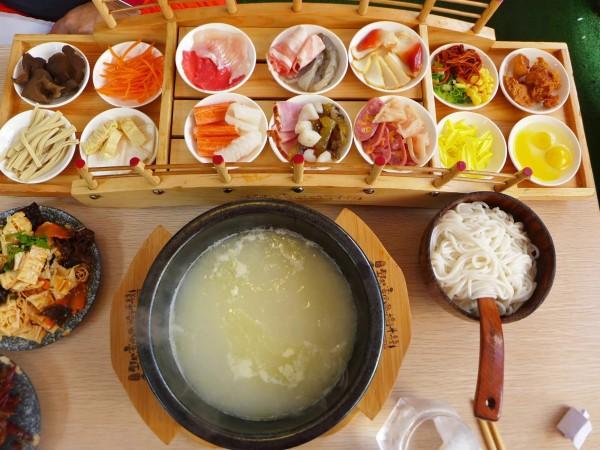
Across the Bridge Rice Noodles (Guoqiao Mixian) - © VnExpress
Festivals & Local Celebrations
Kunming’s calendar is filled with vibrant festivals and local celebrations that reflect the city’s rich cultural diversity. These gatherings provide a special window into the cultures and customs of Kunming's numerous ethnic groups.
- Torch Festival: Celebrated by the Yi people, the Torch Festival is one of Kunming’s most exciting events. Held in the summer, the festival features massive bonfires, traditional Yi dances, and wrestling competitions. The streets come alive with energy as locals and visitors join in the festivities, which are meant to ward off evil spirits and bring good luck.
- Kunming International Flower Expo: Kunming, often called the "City of Eternal Spring," celebrates its love of flowers every year at the International Flower Expo. This event showcases a stunning array of floral displays, highlighting the city’s reputation for horticultural excellence. It’s a must-visit for flower enthusiasts and a beautiful way to experience Kunming’s natural beauty.
- Water-Splashing Festival: This lively festival is celebrated by the Dai ethnic group and marks their New Year. Held in April, the Water-Splashing Festival is exactly what it sounds like—people drench each other in water to wash away bad luck and bring in good fortune. It’s a fun and refreshing way to experience Dai culture and join in the community spirit.
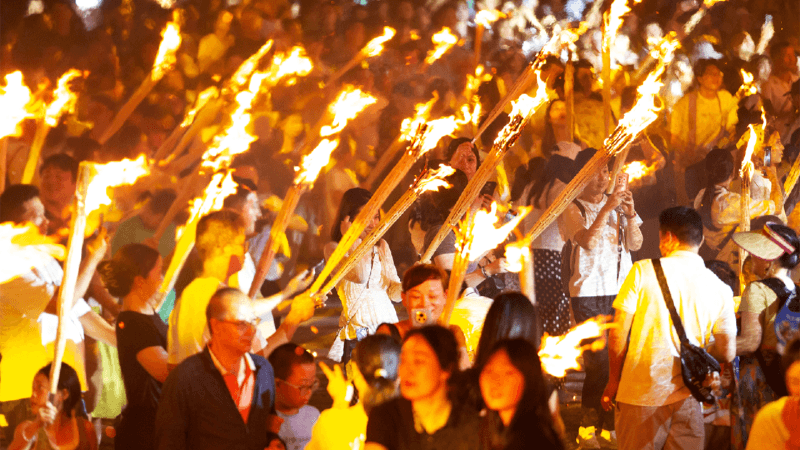
Torch Festival of the Yi people - © CGTN
What to Do in Kunming
- Hike the Western Hills (Xishan): Enjoy panoramic views of Dianchi Lake and explore scenic trails with ancient temples and carvings.
- Visit the Stone Forest (Shilin National Park): Wander through unique limestone formations that create a surreal landscape.
- Explore Yuantong Temple: Discover one of Kunming’s oldest Buddhist temples, known for its serene atmosphere and historical significance.
- Explore Guandu Old Town: Experience traditional architecture and local crafts in this well-preserved historic area.
- Shop on Nanping Street: Browse modern stores and boutiques in Kunming’s main shopping district.
- Browse the Bird and Flower Market: Find unique souvenirs, traditional Chinese medicines, and handcrafted items in this vibrant market.
Shopping in Kunming
- Nanping Street: Explore modern department stores and boutiques in Kunming’s bustling shopping district.
- Bird and Flower Market: Find unique souvenirs, traditional Chinese medicines, and handcrafted goods in this lively market.
- Jinma Biji Square: Discover antiques, calligraphy, and traditional Chinese crafts in this historic area.
- Kunming International Trade Center: A large shopping complex with a variety of stores selling electronics, fashion, and local products. It’s a great spot for finding high-quality items and unique souvenirs.
- Dongfeng East Road Shopping Area: Known for its diverse range of shops, including luxury brands, local boutiques, and specialty stores. This area is ideal for both high-end and everyday shopping.
- Kundu Flower Market: A vibrant market where you can buy fresh flowers, plants, and floral-themed souvenirs. It’s also a good place to experience the local culture and enjoy the colorful displays.
- Yunnan Provincial Museum Gift Shop: Located within the Yunnan Provincial Museum, this shop offers museum-themed souvenirs, traditional crafts, and local art. It’s a great place to find educational and culturally significant items.
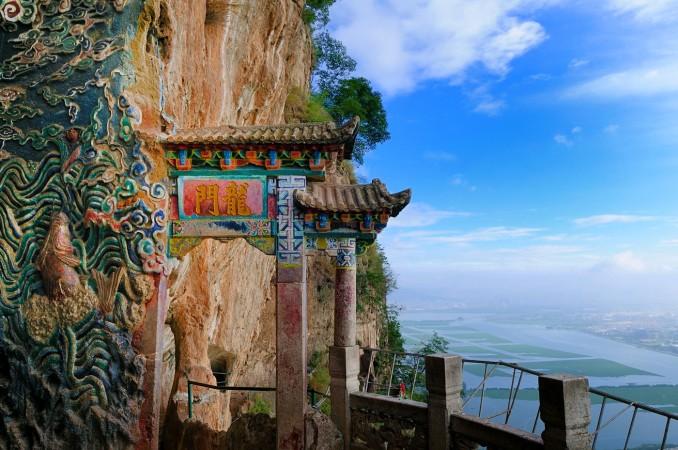
Hiking the Western Hills (Xishan Mountain) - © China Tourism
Weather in Kunming: Best Time to Visit
Kunming, often called the "City of Eternal Spring," offers a mild climate throughout the year, making it a great destination at any time. Here's a breakdown of the weather by season and the corresponding tourism trends:
Spring in Kunming
Spring is one of the best times to visit Kunming, with temperatures ranging from 15°C to 25°C (59°F to 77°F). The pleasant weather and blooming flowers attract many tourists to the city's parks and gardens, such as the Kunming Botanical Garden and the Western Hills. This season is perfect for outdoor activities and exploring Kunming’s natural beauty.
Summer in Kunming
Summer temperatures in Kunming range from 20°C to 30°C (68°F to 86°F). Although it is the rainy season, with occasional showers, the weather remains comfortable compared to other regions. The colder highlands of Kunming are ideal for summer visits, when you may take in the verdant scenery. The rainy season also brings vibrant greenery, enhancing the beauty of natural attractions like the Stone Forest.
Autumn in Kunming
Autumn mirrors spring with pleasant temperatures between 15°C and 25°C (59°F to 77°F) and dry weather. This is a popular time for sightseeing and outdoor activities. The clear skies and comfortable temperatures make it ideal for hiking the Western Hills or visiting cultural sites like Yuantong Temple.
Winter in Kunming
Winter temperatures range from 8°C to 20°C (46°F to 68°F). The weather is generally dry, but it can get cooler in the evenings. Winter is a quieter time for tourism, offering a more relaxed experience with fewer crowds at major attractions. It’s also a good period for enjoying indoor activities and cultural experiences.
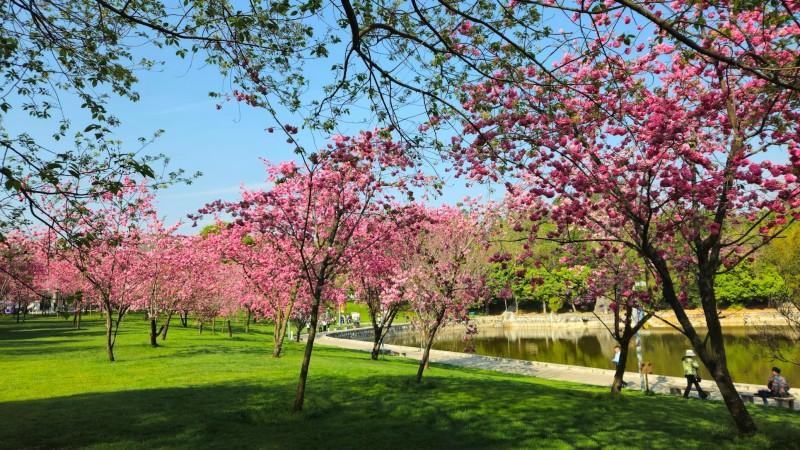
Spring in Kunming - © Chuck Eugene
Culture Etiquette in Kunming
When visiting Kunming, being aware of local customs and etiquette can enhance your experience and show respect for the culture. Here are some unique local practices to keep in mind:
- Warm Greetings: It's customary to shake hands amicably when you meet someone. In more traditional settings, a slight bow or nod of the head can be a polite gesture. Addressing people with proper titles and showing respect for elders is highly valued.
- Dining Etiquette: During meals, it’s customary to wait for the host to begin eating before you start. Sharing dishes is typical, so be prepared to use communal chopsticks provided for serving food. It’s polite to try a bit of each dish offered.
- Respect for Local Traditions: Wear modest clothing and take off your sunglasses and hat when you visit temples or other places of worship. It’s important to follow any posted guidelines and show respect by not touching sacred objects or interrupting ceremonies.
- Gift-Giving: Small gifts or tokens of appreciation are appreciated when visiting someone’s home. Traditional gifts include fruits, sweets, or local specialties. Avoid giving clocks or umbrellas, as they are associated with funerals and bad luck.
- Public Behavior: Public displays of affection are generally reserved and may be seen as inappropriate in more traditional settings. Speaking softly and avoiding loud conversations will help you blend in with the local culture.
- Respect for Nature: Kunming is known for its beautiful natural landscapes, so be mindful of your environmental impact. Follow designated paths and dispose of trash properly to help preserve the city’s natural beauty.
Essential Travel Information
Getting Around Kunming
Navigating Kunming is easy with a range of transportation options. The city has a well-developed, reasonably priced bus system that travels to most locations, including popular districts and sites. For a quicker and more efficient way to travel, the modern subway system connects key areas and helps avoid traffic. Taxis are widely available and reasonably priced, and ride-sharing services provide a convenient alternative. For shorter trips, renting a bicycle or e-scooter offers a fun and eco-friendly way to explore the city. If you're planning to venture beyond Kunming, car rentals offer flexibility, but make sure to familiarize yourself with local driving regulations and road conditions.
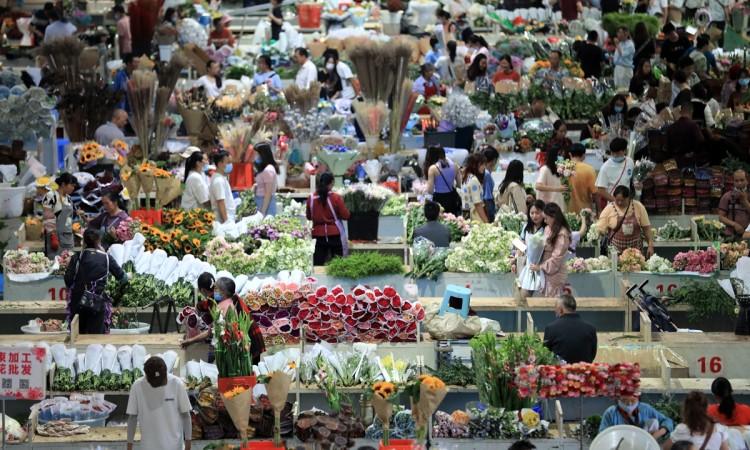
Wander around Bird and Flower Market - © Global Times
ATM & Banking Services
Managing your finances in Kunming is straightforward, with numerous banking services readily available. ATMs are widespread throughout the city, including in major shopping areas and transport hubs, and most accept international cards, though it’s wise to check for any transaction fees with your bank beforehand. Banks offer a variety of services such as currency exchange and cash withdrawals. Additionally, currency exchange services can be found at both banks and dedicated counters, so it’s a good idea to exchange a small amount before arriving to cover immediate expenses.
Where to Stay in Kunming
Kunming has a selection of lodging choices to suit different tastes and price ranges. For a luxurious experience, you can choose high-end hotels that provide top-notch amenities, including spas, fine dining, and central locations. Mid-range hotels offer comfort and affordability, with quality services and convenient access to major attractions. Budget-conscious travelers will find clean and basic accommodations in budget hotels and hostels. For a more personalized stay, consider homestays and guesthouses, which offer a chance to experience local hospitality and gain insights into daily life in Kunming.
Articles for you

Explore Yala National Park - Sri Lanka Travel, Asia
Tucked away in Sri Lanka’s southeastern corner, Yala National Park is where wild nature meets deep tradition. Known worldwide for its leopard population, the park is also home to elephants, sloth bears, crocodiles, and hundreds of bird species. Beyond wildlife, Yala opens doors to a cultural landscape dotted with ancient temples, Buddhist ruins, and coastal villages. For travelers seeking more than just a safari, Yala offers a chance to explore eco-tourism, local communities, and sacred heritage sites.
Population: The Yala National Park area doesn’t have a human population.
Economy: The economy around Yala National Park thrives on a blend of eco-tourism, agriculture, and local services. Safari tours, eco-lodges, and cultural experiences drive steady income for nearby towns like Tissamaharama and Kataragama, supporting thousands of families.
Landmarks: Famous for Block I of Yala and wildlife encounters, including elephants, sloth bears, crocodiles, and exotic bird species.

Explore Galle - Sri Lanka Travel, Asia
Nestled on Sri Lanka’s southern coastline, Galle is a vibrant city where history meets the sea. Its cobbled streets, colonial architecture, and serene beaches make it a must-visit destination for travelers seeking a blend of culture, adventure, and relaxation. A UNESCO World Heritage site, Galle captivates visitors with its Dutch Fort, bustling markets, and friendly locals. Whether you’re exploring the ramparts at sunset or savoring fresh seafood by the shore, Galle promises an unforgettable journey into Sri Lanka’s heritage.
Population: Approximately 113,000 in 2023.
Economy: Galle’s economy thrives on tourism, trade, and fisheries. The city’s historic fort, colonial architecture, and coastal charm draw thousands of international visitors each year, making tourism its main economic driver. Fishing remains vital for local livelihoods, supplying fresh seafood across the region.
Landmarks: Famous for the Galle Fort, Dutch Reformed Church & Maritime Museum, and Unawatuna Beach.

Explore Bentota - Sri Lanka Travel, Asia
Nestled along Sri Lanka’s southwestern coast, Bentota is a tropical paradise that blends golden beaches, vibrant culture, and thrilling adventures. Famous for its calm waters, luxury resorts, and scenic river estuary, Bentota has become a top destination for travelers seeking both relaxation and authentic experiences. From serene beach walks at sunrise to adrenaline-pumping water sports, this coastal town offers a perfect balance of leisure and exploration. With its proximity to Colombo and Galle, Bentota is easy to reach, making it an ideal stop for both short escapes and extended holidays.
Population: Approximately 37,000 in 2023.
Economy: Bentota’s economy thrives mainly on tourism, which drives local businesses such as hotels, restaurants, and wellness retreats. The town also benefits from fishing, coconut cultivation, and handicrafts like wood carving and batik textiles. Many residents rely on the growing demand for water sports and Ayurvedic treatments, making tourism the backbone of both income and employment in the area.
Landmarks: Famous for Bentota Beach, Bentota River Safari, and Kande Vihara Temple.

Explore Mirissa - Sri Lanka Travel, Asia
Mirissa is a charming coastal town on Sri Lanka’s southern shoreline. Known for its golden beaches, turquoise waters, and vibrant marine life, it has become a must-visit stop for travelers exploring the island. Many come for whale watching, surfing, and sunset views at Coconut Tree Hill, but Mirissa offers much more than postcard beauty. The fishing boats you see anchored by the bay carry generations of stories. Local traditions, delicious cuisine, and a laid-back rhythm of life shape every visitor’s experience.
Population: Approximately 4,700 in 2023.
Economy: Mirissa’s economy is largely shaped by its coastal location. Fishing has long been the backbone of local livelihoods, with generations relying on the Indian Ocean for income. In recent decades, tourism has become the main driver of growth, thanks to whale watching, surfing, and beachside hospitality.
Landmarks: Famous for Mirissa Beach, Coconut Tree Hill, and Parrot Rock Bridge.

Explore Nuwara Eliya - Sri Lanka Travel, Asia
Tucked away in the Central Highlands of Sri Lanka, Nuwara Eliya is often called “Little England”. With its rolling tea plantations, cool misty mornings, and colonial charm, this mountain town feels like a step into another world. Travelers come here to breathe fresh air, walk through flower gardens, sip the finest Ceylon Tea, and enjoy a pace of life far from the island’s busy cities. Whether you’re drawn by scenic landscapes, heritage architecture, or the warmth of its people, Nuwara Eliya is a destination that blends nature, culture, and history in perfect harmony.
Population: Approximately 781,000 in 2023.
Economy: Nuwara Eliya’s economy thrives mainly on tea production, as it sits in the heart of Sri Lanka’s central highlands, famous worldwide for Ceylon Tea. The city also benefits from a growing tourism industry, attracting visitors with its colonial charm, cool climate, and scenic landscapes.
Landmarks: Famous for Gregory Lake, Hakgala Botanical Garden, and Victoria Park.

Explore Sukau - Malaysia Travel, Asia
Nestled on the banks of the Kinabatangan River in Sabah, Malaysian Borneo, Sukau is a destination where wildlife, culture, and conservation come together. Known as one of Asia’s top spots for river safaris and eco-tourism, this quiet village offers a front-row seat to encounters with Bornean orangutans, pygmy elephants, proboscis monkeys, and exotic birdlife.
Population: Approximately 1,400 in 2019.
Economy: Sukau’s economy is shaped by its riverine location and natural resources. Traditionally, the Orang Sungai community relied on fishing, small-scale farming, and forest gathering for their livelihood. Today, the village has shifted toward eco-tourism, with river cruises, jungle trekking, and homestays providing income.
Landmarks: Famous for the Kinabatangan River cruises, Gomantong Caves, and Ox-bow lakes and wetlands.
